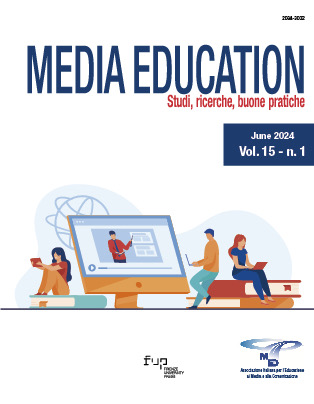Navigo ergo sum: competenze digitali e uso di Internet tra gli alunni della scuola secondaria di II grado
Published 2024-06-12
Keywords
- digital technologies,
- Internet,
- high school,
- learning
Copyright (c) 2024 Alessandro Romano, Caterina Buzzai, Marinella Muscarà

This work is licensed under a Creative Commons Attribution 4.0 International License.
Abstract
The advent of digital technologies has revolutionised communication and learning, profoundly affecting society. This contribution explores the use of the Internet for educational purposes among high school students in Sicily. Using an adapted questionnaire, the behaviours of 470 students were examined, along with potential variations between different fields of study. Exploratory factor analysis revealed a unifactorial structure of the questionnaire, consisting of 10 items. Furthermore, the instrument showed good reliability. The results indicate widespread use of the Internet for academic tasks and revealed significant disparities in the use of the Internet between the various fields of study, with students from science, humanities and foreign language schools using it more frequently than those from technical school. This study provides a valuable tool for understanding the impact of digital technologies on school learning and emphasises the need to promote key digital skills among students.
References
- Affum, M. Q. (2022). The effect of Internet on students studies: a review. Library Philosophy and Practice (e-journal), 6932,1-21.
- Autorità garante per l’infanzia e l’adolescenza (2023). Relazione al Parlamento dell’Autorità garante per l’infanzia e l’adolescenza 2022. https://www.garanteinfanzia.org/sites/default/files/2023-06/relazione-parlamento-2022-def.pdf
- Ayub, A. F. M., Hamid, W. H. W., & Nawawi, M. H. (2014). Use of Internet for Academic Purposes among Students in Malaysian Institutions of Higher Education. Turkish Online Journal of Educational Technology-TOJET, 13(1), 232-241.
- Baroni, F., Greco, A., & Lazzari, M. (2019). Utenti di Internet sempre più giovani: indagine sull’uso del digitale tra gli alunni della scuola primaria. In M. Lazzari e A. Ponzoni (Eds), Palcoscenici dell’essere (pp. 229-240). Sestante.
- Bonaiuti, G., Calvani, A., Menichetti, L., & Vivanet, G. (2022). Le tecnologie educative: criteri per una scelta basata su evidenze. Carocci.
- Bonaiuti, G., & Di Pace, A. (2021). Insegnare e apprendere in aula e in rete: per una didattica blended efficace. Carocci.
- Buckingham, D. (2020). Un manifesto per la media education. Mondadori.
- Calvani, A. (2023). Tecnologie per l’inclusione: quando e come avvalersene. Carocci.
- Commissione Europea (2021). Bussola per il digitale 2030: il modello europeo per il decennio digitale. https://eur-lex.europa.eu/legal-content/IT/TXT/HTML/?uri=CELEX:52021DC0118&from=en
- Commissione Europea (2023). Annex Italy. In Report on the state of the Digital Decade. https://digital-strategy.ec.europa.eu/it/library/2023-report-state-digital-decade
- Consiglio d’Europa (2000). Conclusioni della Presidenza al Consiglio Europea di Lisbona 23 e 24 marzo 2000. https://www.europarl.europa.eu/summits/lis1_it.htm
- Consiglio d’Europa (2006). Recommendation of the European Parliament and of the Council of 18 December 2006 on key competences for lifelong learning (2006/962/EC). https://eur-lex.europa.eu/legal-content/EN/TXT/PDF/?uri=CELEX:32006H0962
- Consiglio d’Europa (2018). Council Recommendation of 22 May 2018 on key competences for lifelong learning (2018/C 189/01). https://eur-lex.europa.eu/legal-content/EN/TXT/PDF/?uri=CONSIL:ST_9009_2018_INIT&from=EN
- Di Sparti, A. (1996). Multimedia, semiotica e meccanismi cognitivi. In G. D’Agostino (Ed.), Antropologia e informatica (pp. 29-39). L’epos società editrice.
- IBM SPSS (2019). Statistics for Macintosh (Version 26.0) [Computer software]. IBM Corp. DOI: https://doi.org/10.4324/9780429056765-3
- Ferri, P., & Moriggi, S. (2018). A scuola con le tecnologie: manuale di didattica digitalmente aumentata. Mondadori.
- ISTAT (2023a). Quasi una persona su due ha fatto acquisti online, +6,5% tra 2020 e 2021. https://www.istat.it/it/files//2023/03/REPORT_CITTADINIEICT_2022.pdf
- ISTAT (2023b). Competenze digitali e caratteristiche socio-culturali della popolazione: forti divari. https://www.istat.it/it/files/2023/12/Cittadini-e-ICT-2023.pdf
- Lévi-Strauss, C. (2008). Tristi tropici. Il Saggiatore.
- Mädamürk, K., Tuominen, H., Hietajärvi, L., & Salmela-Aro, K. (2021). Adolescent students’ digital engagement and achievement goal orientation profiles. Computers & Education, 161, 104058. https://doi.org/10.1016/j.compedu.2020.104058 DOI: https://doi.org/10.1016/j.compedu.2020.104058
- Mallya, J., Lakshminarayanan, S., & Payini, V. (2019). Self-efficacy as an Antecedent to Students ‘Behavioral Intention to Use the Internet for Academic Purposes: A Structural Equation Modeling Approach. Library Philosophy and Practice (e-journal), 3055.
- Ranieri, M. (2022). Competenze digitali per insegnare: modelli e proposte operative. Carocci. DOI: https://doi.org/10.36253/978-88-5518-587-5.6
- Rivoltella, P.C., & Rossi P.G. (2019). Tecnologie per l’educazione. Pearson Italia.
- Sam, H. K., Othman, A. E. A., & Nordin, Z. S. (2005). Computer Self-Efficacy, Computer Anxiety, and Attitudes toward the Internet: A Study among Undergraduates in UNIMAS. Educational Technology & Society, 8(4), 205-219. https://www.learntechlib.org/p/75038/
- Torres Castellanos, M. E., Piraquive Calderón, J. O., & Chiappe Laverde, A. (2023). School engagement and ICT: a systematic review. Profesorado: Revista de Curriculum y Formación del Profesorado, 27(1), 471-501. https://doi.org/10.30827/profesorado.v27i1.24050 DOI: https://doi.org/10.30827/profesorado.v27i1.24050
- Velicer, W. F. (1976). Determining the number of components from the matrix of partial correlations. Psychometrika, 41(3), 321–327. https://doi.org/10.1007/BF02293557 DOI: https://doi.org/10.1007/BF02293557
- Wang, Y., Yasmin, F., & Akbar, A. (2023). Impact of the internet on English language learning among university students: mediating role of academic self-efficacy. Frontiers in Psychology, 14. https://doi.org/10.3389/fpsyg.2023.1184185 DOI: https://doi.org/10.3389/fpsyg.2023.1184185
- West, S.G., Finch, J.F., & Curran, P.J. (1995). Structural equation models with nonnormal variables: problems and remedies. In R.H. Hoyle (Ed.), Structural equation modeling: Concepts, issues, and applications (pp. 56-75). Sage Publications, Inc.

